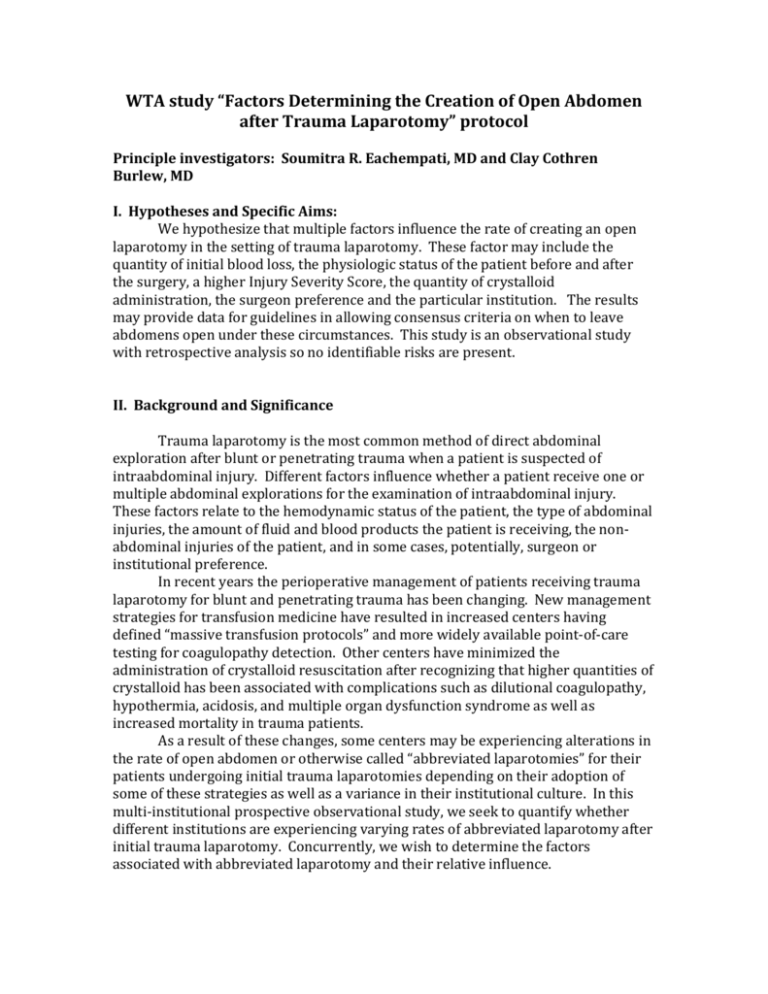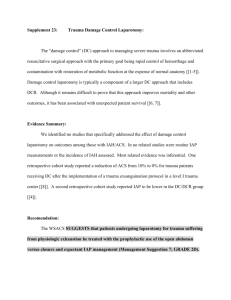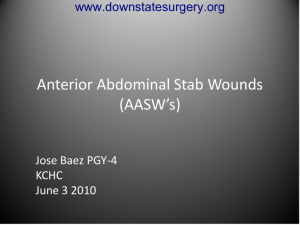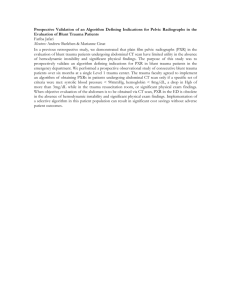Protocol - Western Trauma Association
advertisement

WTA study “Factors Determining the Creation of Open Abdomen after Trauma Laparotomy” protocol Principle investigators: Soumitra R. Eachempati, MD and Clay Cothren Burlew, MD I. Hypotheses and Specific Aims: We hypothesize that multiple factors influence the rate of creating an open laparotomy in the setting of trauma laparotomy. These factor may include the quantity of initial blood loss, the physiologic status of the patient before and after the surgery, a higher Injury Severity Score, the quantity of crystalloid administration, the surgeon preference and the particular institution. The results may provide data for guidelines in allowing consensus criteria on when to leave abdomens open under these circumstances. This study is an observational study with retrospective analysis so no identifiable risks are present. II. Background and Significance Trauma laparotomy is the most common method of direct abdominal exploration after blunt or penetrating trauma when a patient is suspected of intraabdominal injury. Different factors influence whether a patient receive one or multiple abdominal explorations for the examination of intraabdominal injury. These factors relate to the hemodynamic status of the patient, the type of abdominal injuries, the amount of fluid and blood products the patient is receiving, the nonabdominal injuries of the patient, and in some cases, potentially, surgeon or institutional preference. In recent years the perioperative management of patients receiving trauma laparotomy for blunt and penetrating trauma has been changing. New management strategies for transfusion medicine have resulted in increased centers having defined “massive transfusion protocols” and more widely available point-of-care testing for coagulopathy detection. Other centers have minimized the administration of crystalloid resuscitation after recognizing that higher quantities of crystalloid has been associated with complications such as dilutional coagulopathy, hypothermia, acidosis, and multiple organ dysfunction syndrome as well as increased mortality in trauma patients. As a result of these changes, some centers may be experiencing alterations in the rate of open abdomen or otherwise called “abbreviated laparotomies” for their patients undergoing initial trauma laparotomies depending on their adoption of some of these strategies as well as a variance in their institutional culture. In this multi-institutional prospective observational study, we seek to quantify whether different institutions are experiencing varying rates of abbreviated laparotomy after initial trauma laparotomy. Concurrently, we wish to determine the factors associated with abbreviated laparotomy and their relative influence. For this study by participating members of the Western Trauma Association, prospective data collection is performed of all trauma laparotomies from 2015 to 2018 to determine the factors influencing the immediate or staged closure of the patients’ abdomens. Data to be collected include age, gender, mechanism of injury, outcome, injury severity score (ISS) and its components, time from injury to operating room for start of exploration, the duration of the trauma laparotomy, and other procedures performed on the patient. Other data to be included are whether the abdomen was left on and why, as well as the number of laparotomies performed. Further data will evaluate presence of hypotension, initial vitals, fluid administered in the first 24 hours, and postoperative complications, if any. Primary outcome measures include survival, ICU length of stay, hospital length of stay, and number of trauma laparotomies. Statistical analysis will be performed to determine predictors of creating the open abdomen after trauma laparotomy. A multivariate logistic regression will be performed based on significant factors after univariate analysis. No specific internal or external funding is provided for this study. This study is a multi center study and hopes to answer which features are present in leaving the abdomen open after trauma laparotomy. III. Research Methods A. Inclusion/Exclusion: Patients receiving trauma laparotomy from 20152018 are to be studied. Excluded patients are those whose data are not available for analysis. B. Outcome Measure(s): Clinical outcome measures include rates of open abdomen per institution and surgeon, infectious complications, and mortality for trauma laparotomies performed with and without open abdomens will be measured. Additional variables that would impact these outcomes will also be recorded. . C. Description of Population to be Enrolled: All patients receiving a trauma laparotomy, both blunt and penetrating, will be evaluated in the study. D. Study Design and Research Methods: This is a prospective observational study. Data to be collected is noted on the attached data abstraction form. E. Description, Risks and Justification of Procedures and Data Collection Tools: Data will be abstracted from the medical records of patients prospectively (the data abstraction form is attached). The data will be deidentified, and entered into a database by the PI without patient identifiers. A coded identity will be assigned that reflects the order in which a subject was entered into the database; it will not be based on subject information. The database will be kept on a password-protected computer in a locked office. Data abstraction forms will be kept in a locked office. The database code will be noted on the data abstraction form in the event that a patient will need to be re-identified. These forms will be destroyed once all analyses have been completed and the project concluded. F. Consent Procedures: Waiver of informed consent is requested. There is no more than minimal risk to the patient, and it will involve only collection of data that has been collected for medical diagnosis and treatment purposes. There will be no contact with the patient. The data will be de-identified and thus the rights and welfare of the patient will not be compromised. Without this waiver the study could be compromised because of an inability to collect data on every eligible patient. This could lead to misinterpretation of the results. G. Data Analysis Plan: Demographic data will be compared between groups with descriptive statistics. Categorical treatment variables will be analyzed using chi-squared test. H. Funding: This is an investigator-initiated study for which there is no direct funding. I. Summarize Knowledge to be Gained: The role and utility of the open abdomen in patients with a trauma laparotomy.











